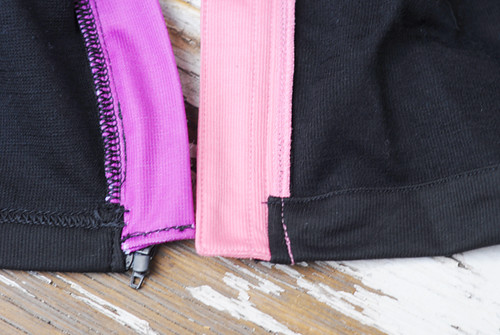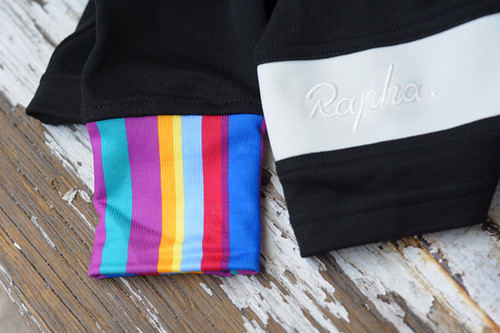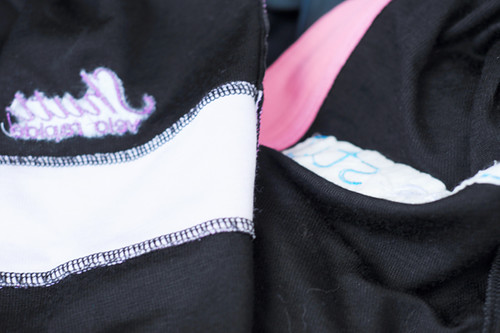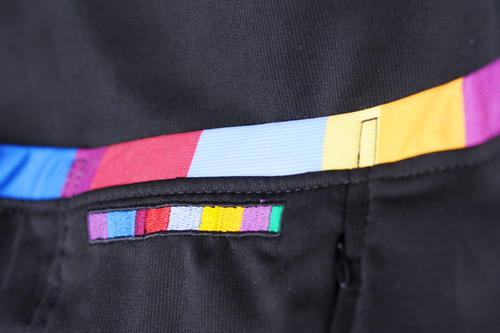Wool/Poly Blends for Cycling?
While merino wool has become a popular fabric choice for bicycle clothing, it seems that many manufacturers choose to use wool/polyester blends instead of pure merino, believing that the right combination can deliver the best results. Rapha and Road Holland use a fabric called SportWool. Shutt Velo Rapide uses MerinoPerform. Swobo refers to their blend as Merino 753. I am sure there are other proprietary names, but judging by the descriptions of these fabrics the idea is essentially the same: The blend is formulated to have wool fibers on the inside and polyester fibers on the outside, which the manufacturers believe delivers ideal performance properties.
Observing the way these blends have been marketed over the past couple of years, I've noticed an interesting dichotomy. The fiber content shows that merino comprises only 20-40% of it, whereas polyester comprises 60-80%. Yet the names of the blends inevitably feature the words "merino" and "wool," with no mention of the dominant synthetic content. To me this suggests that the manufacturers are eager to promote their use of wool given its current popularity, but in fact do not believe it is possible for wool to be a performance fabric - hence the idea that wool needs to be improved upon (by adding polyester) in order to be used in cycling clothing. All of this has made me highly skeptical about the wool/poly blends. But over the past few months I've had the opportunity to wear several garments made of these fabrics, and gave them an open-minded try. What follows are my impressions.
Having joined a local cycling club last December, I received their club jersey (right), which happens to be made by Rapha out of the aforementioned SportWool. A couple of months later, I received some items for review from Shutt Velo Rapide, including the Women's Training jersey (left), made of MerinoPerform. Both jerseys are 40% wool, 60% polyester. The texture and weight of the fabrics appear to be identical.
On the outside, the wool blend fabric is smooth and has a slight sheen to it. On the inside it is matte, soft and slightly textured. To the touch, neither the outside nor the inside feels like true merino, but the inside comes closer.
I have worn both jerseys over a (thin, 100% wool) base layer as well as directly next to my skin. I am sensitive to polyester was was curious whether this blend would engage that sensitivity.
However, worn directly next to skin I found the jerseys inferior to the pure wool alternatives. In warm weather the wool/poly blends do not breathe as well for me, and I feel clammy wearing them. I also find them less versatile for temperature regulation when worn on their own. On one ride I found myself too hot in the jersey at 85°F and too cold at the end of the ride at 65°F. I know that my long sleeve 100% wool jerseys are more versatile over the same temperature range.
As far as polyester sensitivity, I experienced it with the Rapha jersey when worn directly next to skin, but not with the Shutt Velo Rapide jerseys. I think the reason is simply that the former fits me tighter, so it comes into closer contact with my skin. Either way, after wearing the Rapha jersey in 80°F weather without a base layer underneath, I promptly got a rash under my arms. To be safe, I won't be wearing either of the wool blend jerseys without a base layer again.
In summary, I have learned that for me the wool/polyester blends function extremely well as outer and mid layers in cool to freezing temperatures. However, they do not function well for me when worn directly next to skin in warmer temperatures - both failing to provide the same temperature regulation as pure wool and activating my polyester sensitivity when coming into close contact with my body.
I am curious about others' experiences with wool/polyester blend fabrics from these and any other manufacturers. How do you find them for cycling compared to 100% wool or 100% synthetics?








The major drawbacks of wool are sagging under loaded pockets and absorption (to the point of sagging) of heavy sweat or rain. The synthetic % of the fabrics helps to mitigate this problem. That being said, I love all of the wool or part-wool jerseys I own. I wear the 100% jerseys for short/casual rides without rain or full pockets, and the part-wool with or without a baselayer all the time. If you want printed/sublimated graphics, you're stuck with poly. The quality/detailing of the Rapha Classic Jersey is exceptional, making it my favorite.
ReplyDeleteThe Rapha jerseys are indeed very well made, with the exception that some have inner pockets made of non-breathable material.
DeleteI have not experienced the sagging problem in my wool jerseys, including when I get soaked in the rain wearing them. And I carry things in the back pockets too. I wonder whether this is brand/manufacturer dependent.
I don't have any items exactly like what you're describing, but I know that I often wear wool next to the skin and put synthetics on over them. Wool feels so nice next to the skin, but the synthetics are cheaper and easier to find and can take more abuse and they dry a lot faster.
ReplyDeleteI do wish that more of the technical wool companies would put a tiny amount of synthetic in their wool stuff--just 10% or so--because it would make the fabrics more durable. I've had to repair several of my wool items because they got runs in the material or snagged. It works, but it's not the most attractive thing.
Those rainbow colors are an amalgam of the Julie Krasniak Rapha/Focus team kit and some thrift store dress she got for sswcx champs in SF.
ReplyDeleteI've been trying to figure out what came first - the Rapha Focus or the SVR rainbow.
Deleteperhaps a bigger part of the declining wool content over the past few years is the wild instability/shortage of wool in the market. meanwhile, synthetic fibers have remained quite stable/not subject to such variation in supply/demand and pricing.
ReplyDeletePatagonia used to make some wool/poly blends (perhaps still do, don't know). I had several of them and liked them well enough.
ReplyDeleteThen Outlier came along with their ultra-fine Merino Polo shirts. I bought one and liked it so much I bought 4 more. Good thing. to Anon 2:06's point, Outlier is not currently offering the Polos, apparently because it is hard to get the right quality merino wool.
Last two winters (although this winter really cannot be said to be a winter) I've been wearing Loro Piana cashmere/wool blend sweaters under a 100% poly Cadence windbreaker, with either a Swrve or Patagonia merino baselayer depending on the temperature and wind speed.
I find these options much more comfortable than the wool/poly blends.
I had no idea there was a merino shortage, will have to look this up!
DeleteOutlier does not really have a searchable blog. As I recall, they said the big buyers (Rapha? Ibex?) were hoarding all the quality ultra fine wool meaning the polos would be prohibitively expensive.
DeleteWhich of course is saying a lot. Outlier is a great product I highly recommend, but it ain't cheap.
If you reach out to them, perhaps you could encourage them to consider more product for women. The offerings are kind of male centric.
Patagonia's Merino baselayers are currently made with a wool-poly blend. They used to be 100% wool but are now 90% wool/10% poly for increased durability.
DeleteIf I were to have conducted the same tests, my conclusions would have been subject to confirmation bias. I have long felt that wool is flatly superior to almost anything else for comfort over a wide range of conditions including wet, for stink and soil resistance, for colorfastness and good drape, and value when properly cared for. It has been a few years now since my wardrobe included any garments that aren't 100% wool (minus bits of elastic or nylon here and there).
ReplyDeleteI've been experimenting with these fibers this past winter too. Living in Portland, OR, our winter riding weather this season ran the gamut between low 30's to mid 60's. Occasional snow, but mostly rain/sun combo. I bought myself a pretty pricy 100% merino wool sweater (Smartwool) after riding a couple winters with poly blends and not being very well regulated. I found similarly to yourself, that merino against the skin is by far the best for comfort and breath-ability, as well as for the range of temps it supports. I've paired my sweater with a thin poly layer on top for serious cold weather, and with a breathable rain jacket for those soggy or really cold wind days. It feels like I'm finally able to say I've found the right combo for just about anything, especially since each of the layers (besides the sweater) take up very little space in a bag when not needed! Glad to hear a corroborating story.
ReplyDeleteThese blends annoy me soo much. They cost almost as much as a basic wool garment but get stinky just about as fast as the regular synthetics. But worse, the approach for reducing the funky smell of the poly (1/2 hour in a weak vinegar/water soak) seems to dramatically reduce the life of the wool fibers.
ReplyDeleteNow I just buy a few long-sleeved running tops on sale every spring and wear them over my regular base layer of human wool and fling them away when they get tangy. I've always been able to wear wool by itself and couldn't understand why some people can't until my wife brought it to my attention that the wool never actually touches my skin...
Spindizzy
Yeah, men have an advantage, in the winter at least, with their facial and body wool. But does it keep you cool in the summer?
DeleteI don't know if it helps keep me cool in the summer although I suspect it does. I almost never spend much time on the bike in the summer without a light-colored long-sleeved top because I think the sun adds more heat than my arms can radiate and maybe that's from the "insulation".
DeleteIn the interest of scientific inquiry perhaps I should get sheared and polished to see what effect eliminating the air gap from the equation would have. I should probably only shear one side of my body so as to have a "control", I'll get back to you...
Spindizzy
I too prefer the 100% wool not the blends. It is simply more comfy. I have a few Patagonia "wool" blend base layers and I must admit - they are not quite as comfy as the 100% merino wool.
ReplyDeleteAt work, by the way, I only wear wool or cashmere (100%) sweaters - not cotton or poly for me.
I see that Rapha also sells a 100% merino womens jersey as well as merino base layers. Would love to read a review of those if you have a chance to try them.
ReplyDeleteI own their long sleeve base layers (bought a 3-pack in December) and like them very much. Note that the sizing is weird. I am a S/10 in Rapha women's wear, but need an XXS base layer.
DeleteThe 100% merino jersey they just started selling is for city riding and not for roadcycling; does not have proper rear pockets. I am not sure why one would need a cycling jersey for the street, but that is a separate topic.
We in Australia used to live on the sheeps back but those days are long gone and after years of drought the sheep numbers, although still high, have plummeted since the boom years and will never return. Wool prices are not bad at the moment so farmers can get some return as against going broke years ago with the introduction of synthetics. Another reason for wool's demise was coarse fibres that caused uncomfortable itching and the conclusion that all wool had this affect. The stuff used these days should be around the 18 micron fibre diameter and this is bendy enough that is doesn't trigger a nerve response that in turn leads to itching. By the way, because it is merino in itself doesn't mean that it is all around the 18-20 micron diameter but merino is the marketing strategy. The Australian CSIRO developed Sportwool for the Olympics some time ago and it is more durable than 100% 18 micron wool but to me at least, it is a second choice option. The other concern is the cost of ultra fine wool, apart from sales it is expensive and no cheaper here unless you get lucky. It seems weird that I could buy an 18 micron wool jersey that had used Australian wool, woven and manufactured in China (to a high standard) and sold to me via the United States. For me, with the usual expected bias, you cant surpass ultra fine wool for almost anything, I wish I could afford more of it.
DeleteIn regard to Rapha's weird sizing, the same applies to the mens collection: with Rapha's polo shirts in size Medium being a snug fit, their v-neck base layer would have to be XS or XXS for a fit close to the body. Also, even for small sizes the shoulders are very wide, so make sure you've had your dose of weight lifting before buying one of those.
DeleteSome number of decades ago when I was in my college outing club, and polypropylene was the latest hi-tech thing, a lot of people were using base layers that were poly on the inside and wool on the outside, so that's not really that new. The wool provided better insulation than poly, but the wool that was used was scratchy and harsh, so the poly liner helped a bit for comfort. (But then we also used a lot of military surplus stuff!)
DeleteI am always surprised how well 100% merino passes the sniff test when I am deciding what to wear to work in a rush. As someone opposed to using underarm crap I am doubly amazed. But throw a synthetic layer in the works and bam!!! Stinky! At work in the produce cooler where I abide for hours, I must be warm, so have taken to wearing an old wool coat. The lining is synthetic so traps air and odour. It is warm, but does not breathe. For me, having a 'merino' jersey contain mostly polyester completely defeats the purpose of this amazing renewable natural material. I am such a snob I refuse any polymix, although i went to a clothing swap tonight and brought home a couple of sweaters with a poly mix which I might turn into skirts or something....but definitely not for tops.
ReplyDeleteRapha is high end, so a bit confusing that it would skimp on the merino content so much.
I do worry that some of the merino has a high carbon footprint, but that is mostly because the bulk of merino sheep seem to live in New Zealand. Companies like ibex could be sourcing north american merino and even supporting North American merino farmers....it would make me feel a bit less guilty for being clothed head to toe in 100% merino!
It is not my impression that either Rapha or the others are using the blends instead of pure merino as a money-saving tactic. I think they genuinely believe the blends provide superior performance to pure wool.
DeleteIbex has recently announced that they will be sourcing their wool from the US from now on, which is pretty great.
Got the Rapha Jersey yesterday referenced in your March 22nd posthttp://www.rapha.cc/images/gallery/3134-50.jpg and it is great construction but the sport wool seems too heavy for summer wear and surprisingly small for me-something that doesn't happen often. So, nice jersey but as you say more limited in what I can do with it especially when compared to the Ibex Indie jersey you mentioned that I also have and is now my go to jersey for summer riding due to it's properties that you have so excellently described. Thanks! Jim Duncan
ReplyDeleteI love my 100% merino base layers, and wear them almost year round. My biggest complaint (like April) is that they are not very durable, and tend to get holes and runs fairly easily, and replacing them is very expensive. I would be interested to see a small polyester content (like 5%) to help mitigate this.
ReplyDeleteAnother thing to remember when we're talking about blends is that the fibre content percentages are based on mass, not volume, and that wool is much denser than any synthetic. This means that a 60/40 poly/wool jersey would be more like 80% polyester by volume, and though the wool content does make a difference, it's basically still a polyester jersey.
I think there's a place for both Fabrics. I wouldn't wear anything other than wool socks, but I feel like synthetic, specifically exofficio, absolutely kills it for underwear.
ReplyDeleteaf
It is good to see wool "has become a popular fabric choice for bicycle clothing". But it would be more accurate to add, "once again". Up until around 1980, 100% wool was what all cycle clothing was made from - including, or especially, that worn by competitive cyclists. Of course, hard as it may be to imagine now, our wool cycling shorts also had real chamois leather crotches too. And, yes, we hand-washed this kit. Ah, those were the days.
ReplyDelete